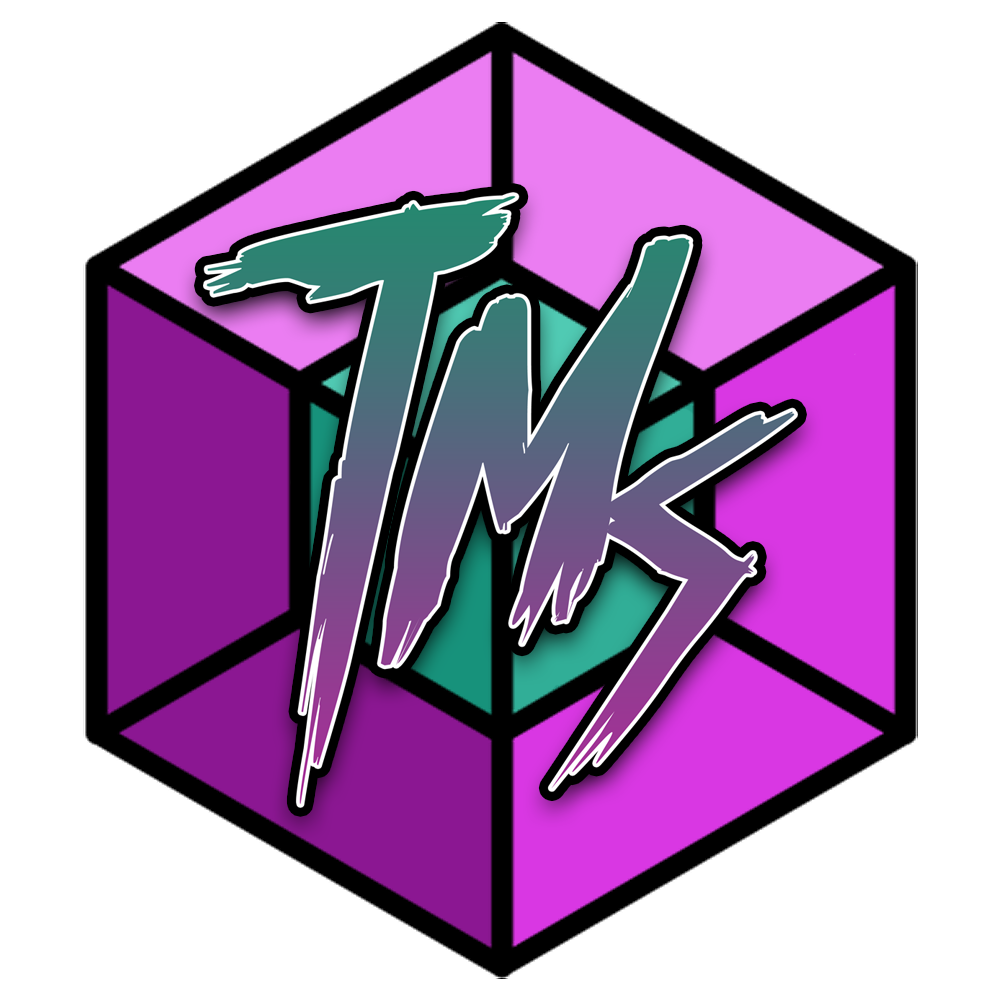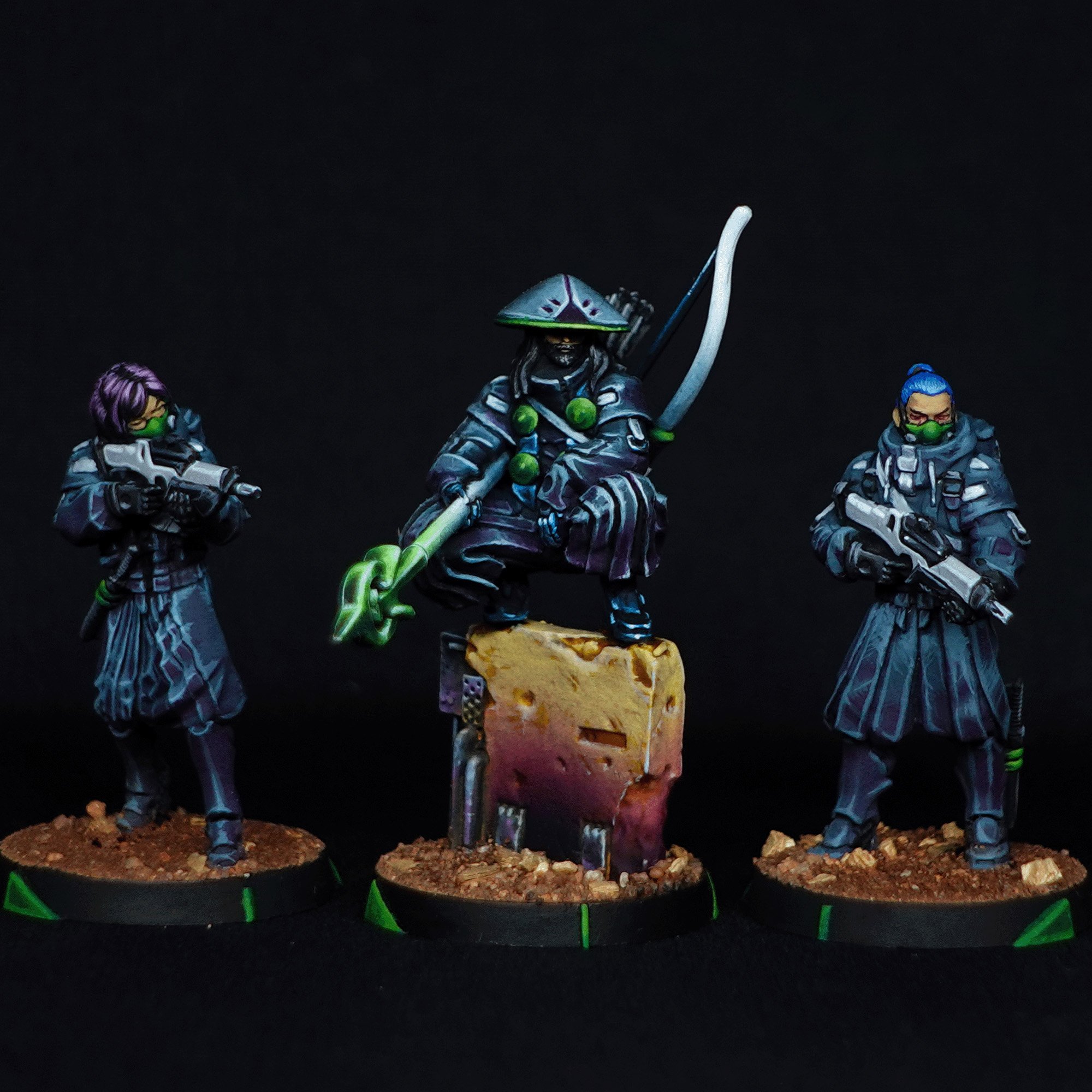Operation: Sandtrap
The box art is so slick!
As huge fans of Infinity, it would be kinda wild if we didn’t make it a priority to talk about the latest Battlebox on this brand new blog. Infinity has just entered its 5th edition, and whilst I don’t currently have any N5 games under my belt…I have spent a fair bit of time with this box.
Unlike with previous Battleboxes, where both of the armies were new to me and presented a chance to explore painting some models I hadn’t previously dealt with, Sandtrap is a little different.
Ninja, from my previous JSA army.
You see, I’ve collected JSA previously (That’s the Japanese Secessionist Army, for those of you new to the game), and I was…well… not really very happy with my efforts on them.
The above Ninja was probably one of the highlights of the whole army, and thanks to a horrible accident with some varnish, as you can see, he’s somewhat ruined by speckle marks, visible all over the blacks. My painting on the whole army was often way below the standard I set for myself.
Fortunately, I don’t scare easily when it comes to painting, and I love a good redemption arc. I had found my reason to want Sandtrap and as luck would have it, Corvus Belli sent me a review copy, so I even got it a little early!
My focus for this box was JSA, and that would likely mean they will become my focus for N5 too. Now I played a fair bit of JSA in N4 and whilst I could never quite make them work for me (a fact I put down to generally not being great at miniatures games… because I spend all my time painting!), I did REALLY enjoy their playstyle.
There’s little more satisfying in Infinity, than running smoke-throwing bikes up the map whilst your support units potter about, taking advantage of the distraction and doing naughty things.
But before I can get to N5 games… before I can look at how much JSA have changed with their new Sectorial. Before I can really know anything about the state of play in late 2024 to early 2025…I needed to paint my damn minis!
The Pre-Order LE Yamabushi.
Now then. As a professional painter, I find myself frequently trapped in a really awkward spot where it comes to my own miniatures.
You see, my job, like many nowadays is very reliant on social media. In my case, YouTube and Instagram. This means that if I’m going to take time off from painting customer’s minis, I at least have to still make content with it. As a result of this I’m often placed in a difficult spot when it comes to what to do.
Going all out on a paintjob will always yield better results on social media, potentially attracting new customers and improving the business profile. Doing so, however, means actively taking longer away from commissions, than if I did a quick and dirty paintjob - something I find very hard to justify morally. This is somewhat amplified at the moment too, because I’m trying to enter a lot of competitions…which already means I have high effort paint jobs that aren’t for clients, scattered about my studio.
On the other hand, its much easier to justify a speedpaint and “Just get it done” is often a great way to be able to get painted minis on the table quickly. But the thing is… I don’t play that often. I’m a painter. In an ACTIVE year of gaming, i’ll maybe have 10-20 games. Speedpainting my armies isn’t really satisfying for me, not to mention it tends to also mean I fill my social feeds with minis that don’t really attract new business. Kind of a lose-lose.
A Selection of my New JSA.
I needed to come up with a way I could paint these beautiful new miniatures quickly, but still produce something impressive, that might inspire a few people and hopefully something I could squeeze a little content out of.
I hope that by this point, the images of my JSA that I’ve shown, illustrate that I succeeded in this. The story of how I got there though, and the ultimate results, were really surprising to me.
To establish a little background, I am not a fan of slapchop. For the uninitiated, this is the name given to essentially painting En Grisaille, but in miniature form. You first spray paint the miniature with a light map, using a black base and a top down white application. Once this is established, you use transparent paints over this value guide, to fill in the colours. This is a very quick method for painting miniatures and produces results that many newer painters will find super impressive.
What’s the issue then? Sounds fun. Sounds accessible… Right?
Wrong.
Slapchop requires completely separate methodology and equipment to traditional miniature painting. It uses either two rattle cans or an airbrush to establish the colour map (typically, although this can be kind of achieved with drybrushing if you’re really careful and clean) and requires a decent collection of Contrast Paints (GW), Speedpaints (Army Painter) or Instant Colours (Vallejo). It also wrecks brushes. In addition to this its VERY hard to correct mistakes because the transparent paints, by design, have poor coverage, and the base layer under them is a gradient, not a flat colour.
Slapchop IS quick…and it IS low effort. However to get GOOD results with it, that hold up against well painted traditional minis…you already need to be a good painter. This is something I find true of Contrast style paints in general.
New painters that achieve success with Slapchop tend to do so at the cost of developing their core painting skills. If you’ve been in the hobby for years and always struggled because you don’t like painting…this is a great technique for you. But as a beginner, coming in to the hobby, it’s a huge trap which could lock you in to a product-driven painting methodology, that stifles your progression longterm.
Trauma dumping aside… this method IS quick and whilst I don’t personally support it, I did see some value in using it as a launching point for my JSA scheme. I already have airbrushes, I might be able to come up with something…And so I mulled.
During this time, I’d recently caught a video by Ninjon which I loved, where he did some basic volume work with an airbrush then expanded it out using the brush. This still gave him a fast result, but allowed him to use the precision of the brush to finesse the miniatures. It was this (Thanks Jon!) that finally gave me the lightbulb moment.
A Closer Zoom.
By starting with the airbrush and laying down a coloured, top-down light map (a mix of what Jon did and Slapchop), I could then expand out the brighter colours in to a quick, brushed on highlight scheme. Slap on some accent colours that are poppy and rich…and boom! Finished mini. This methodology was faster than my usual all-brush approach but cleaner and easier to correct than Slapchop. Perfect.
Turns out, my audience agreed too, with the models receiving a ton of praise on Instagram and starring in a pretty successful video on my YouTube channel. I was made up! Over the moon! Absolutely beaming! Except there was a comment on my socials that immediately made my heart sink.
“I love this scheme… I wonder how it’ll look on a bigger model, like a TAG.”
For those who don’t know, TAGs are big armoured suits in Infinity - usually on a 55mm base and typically full of hard angles and sharp edges. They’re kind of an inevitable part of collecting Infinity, despite not necessarily making it to the table super often. This was… not…what I planned this paint scheme around.
So, I guess I had to paint a TAG. I really felt like I had no choice. I’d cooked up this lovely scheme and nice fun and easy method, but if it didn’t transfer well to Infinity’s big robots, it would be a huge let-down for anyone in my audience looking to replicate my results.
The Mekazoid TAG.
Fortunately for me, I needn’t have worried. By sheer chance, luck and serendipity, the EXACT same approach produced results on a big boy that I was really happy with. As a concession to time I had to be a bit less tidy, but I think sometimes when you’re painting a big ole model like this, you can get away with that.
I was not only relieved, but also truly delighted to have found a painting method for my new JSA that worked for me, and that my audience seemed to connect with. I dubbed my method Chapslop, both because it sounds gross (and I’m a child) and because it pays homage to what inspired it. Slapchop, and a chap named Jon.
The cherry on the cake in this story came right at the end of 2024, though. I always submit a few of the pieces I’ve painted in any given year, to the online MPO competition. Its a big comp, with the best painters in the world entering yearly, but it’s nice to have a crack and sometimes you get a little bit of dopamine from the results.
I entered the squad pictured throughout this article as my “Unit” category entry for the 2024 competition. I did this mostly because I didn’t really have much for unit that I wanted to enter. I did it because I just thought it would be cool to get more eyes on the squad, the method and those lovely new N5/Sandtrap minis. I did not enter them expecting any results (In fact I had all my hopes pinned on my bust entry this year)…so Imagine my surprise when they picked up a bronze!
The pictures you’ve been looking at whilst reading this entry are the literal, actual photos I submitted to the comp and the judges deemed them worthy of reward. Considering they were taking 2-3 hours per model on average, that felt HUGELY vindicating.
So… My experience with Sandtrap has been amazing so far. Not because of the new terrain style (which IS thankfully easier to build than the old stuff), not because of the N5 rules and not because of the exciting new profiles and sectorial for a faction I love. My experience with Sandtrap has been incredible because it sparked inspiration, which snowballed in to a really fun little journey. One of many highlights of 2024 for me, and for the studio.
It really is a treasure, to find such inspiration in little boxes of toy soldiers. We’re very lucky to have this hobby, and I feel lucky to have Corvus Belli.







